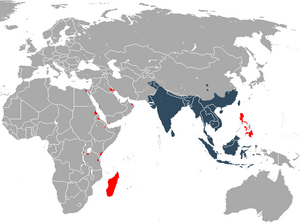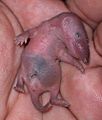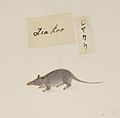Asian house shrew facts for kids
Quick facts for kids Asian House Shrew |
|
|---|---|
 |
|
| Conservation status | |
| Scientific classification | |
| Genus: |
Suncus
|
| Species: |
murinus
|
 |
|
| Asian house shrew range (blue — native, red — introduced) |
|
| Synonyms | |
|
Sorex murinus Linnaeus, 1766 |
|
The Asian house shrew (Suncus murinus) is a small, mouse-like mammal. It's a type of shrew that originally comes from South Asia and Southeast Asia. This shrew is the biggest kind of shrew! Scientists say it's a "Least Concern" species, meaning it's not currently in danger of disappearing. However, it has traveled to new places like parts of Western Asia and East Africa, where it can sometimes cause problems for local animals and plants.
Contents
What Does It Look Like?
The Asian house shrew is usually between 100 mm and 150 mm long. That's about the length of a pen! Adult females weigh from about 23.5 grams to 82 grams. Adult males are a bit heavier, weighing from 33.2 grams to 147.3 grams.
These shrews have short, thick fur. Their fur is usually a color between mid-grey and brownish-grey.
Where Do They Live?
Asian house shrews are originally from South Asia and Southeast Asia. But over time, they have traveled to many other places. You can now find them in eastern Africa, the Arabian Peninsula, Madagascar, the Philippines, and other islands in the Indian Ocean and Pacific Ocean.
They can live in many different places. You might find them in forests, on farms, or in areas where lots of people live. They are often found inside houses and businesses. They mostly live on the ground.
What Do They Eat?
Asian house shrews are mainly insectivores. This means they mostly eat insects. But they also eat other things like small mammals, plants, and even human food.
How Do They Behave?
These shrews are very adaptable animals. They can adjust to many different environments. They are also nocturnal, which means they are most active at night. Scientists believe they mostly live by themselves.
How Do They Have Babies?
Asian house shrews can have babies all year round. A mother shrew usually gives birth to one to eight young ones at a time. The pregnancy lasts for about one month. They start having their own babies when they are around one year old.
How Do They Affect Humans?
Asian house shrews can be helpful because they eat many pests, like insects. However, they can also be a problem. When they move to new places, they can become an invasive species. This means they might compete with local plants and animals for food and space.
Sometimes, they are also considered a pest themselves. They can damage food and other materials found inside homes and businesses.
Images for kids
See also
 In Spanish: Musaraña casera para niños
In Spanish: Musaraña casera para niños






